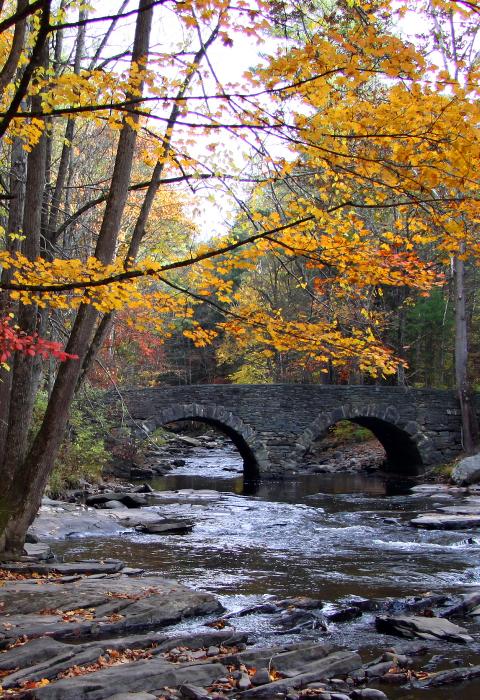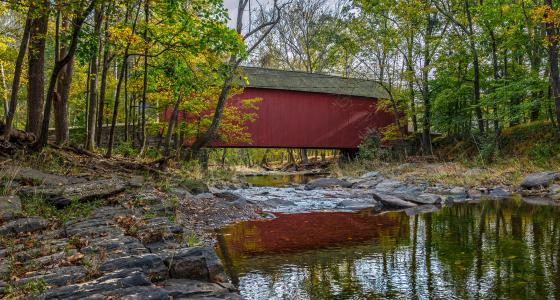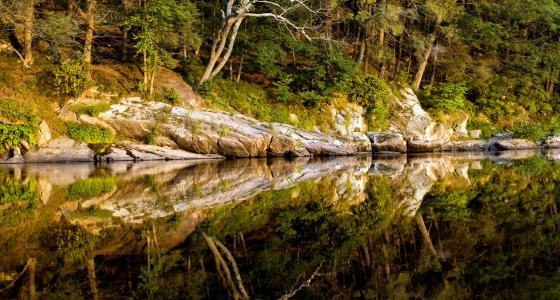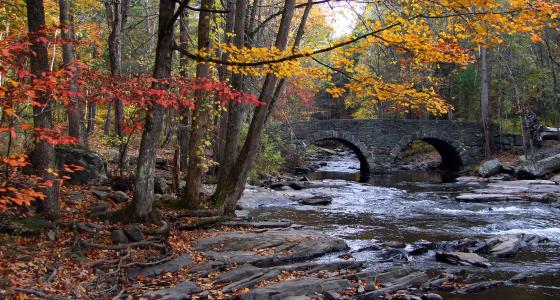Delaware (Upper) River
Delaware (Upper) River
New York, Pennsylvania
This 73-mile stretch of river flows between Hancock and Sparrow Bush, New York, along the Pennsylvania border. The Roebling Bridge, believed to be the oldest existing wire cable suspension bridge, spans the river. The river provides a relatively undeveloped and varied river setting that is ideal for families and recreationists of all levels. The upper Delaware River is known for its outstanding recreational activities, from tubing the rapids on a hot summer day to relaxing on a hidden deck, slope side in the Pocono Mountains, or Catskill Mountains forests. The river’s close proximity and accessibility attracts visitors from major metropolitan areas along the northeast corridor, including Boston, New York City, Philadelphia, and Washington, D.C.
Designated Reach
November 10, 1978. The segment from the confluence of the East and West Branches below Hancock, New York, to the existing railroad bridge immediately downstream of Cherry Island in the vicinity of Sparrow Bush, New York.
Outstandingly Remarkable Values
Culture
Dating from the paleo through the transitional period, 437 documented pre-contact archeological sites record a rich cultural tapestry of riverine occupation of aboriginal people who used the river as a trade route. Several privately owned archeological sites illustrate the history of early European settlers who arrived in the mid-18th century. Remnants of the early settlements along the river help to convey the history of the early subsistence period to the mid-1700s.
Ecology
The upper Delaware River exhibits some of the highest ecological integrity found in any of the large rivers of this region. As the least-developed section of the last major river on the Atlantic Coast, undammed the entire length of its mainstem, the upper river is largely ecologically intact. Its free-flowing character supports key components and processes that contribute to the superb natural resources found here.
The riparian area along the river supports rare terrestrial plant communities, such as ice scour rock outcrop, seep communities, and bitternut hickory lowland woodland. The river itself sustains diverse and healthy native aquatic plant communities, including a plentiful population of threadfoot riverweed, a relatively rare aquatic plant that is indicative of excellent water quality.
Geology
The upper Delaware River is an exceptional example of a deep, narrow river valley cutting across the Small Lakes section of the glaciated portion of the Appalachian Plateau. The overall landscape is a fluvial or stream-cut landscape modified by stream derangements from glacial deposits burying portions of preglacial valleys. Examples of significant geologic features include sandstone cliffs, barbed tributaries, glacial deposits, glacial outwash terraces, diverse channel morphologies, exposed ancient bedrock, bedrock knobs, cutoff incised meanders, island complexes, gorges, and fossils.
The convoluted drainage pattern of the Delaware River system provides a rare combination of drainage anomalies that challenge various explanations of how Appalachian river systems evolved over geologic time.
Recreation
River activities include canoeing, kayaking, boating, tubing, rafting, SCUBA diving, snorkeling, swimming, and hunting waterfowl. The upper Delaware’s cold-water fishery between Hancock and Callicoon attracts anglers from around the world, especially those interested in fly fishing for its world-renowned wild trout. This type of fishing experience is seldom found elsewhere in the region.
Scenery
The scenic quality of the upper Delaware River is recognized as regionally significant due to its picturesque gorge, riparian vegetation, steep forested slopes, and gently rolling hills. The agricultural fields and livestock pastures add variety to this tranquil scene.




